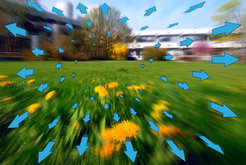Optic flow
The optic flow enables us and many other animal species to relate the body’s own movements to those of the environment and thus to stay on course. A photo can illustrate optic flow if we take a step forward with a camera while the aperture is open (see illustration). The image of the environment moves past our eyes, and the camera, in the opposite direction.

In this situation, optic flow describes the characteristic distribution of local motion directions across the visual field. Objects at different distances move at different speeds on the retina of the eye.
With the aid of optic flow, the brain calculates answers to motion-relevant questions: Do I move, or something in the environment? Which direction am I moving in? Am I moving straight ahead or am I turning? How far away are the objects from me? When do I encounter one of the objects? This information helps, for example, to avoid a collision. These interrelationships also enable the navigation of self-driving cars and the gentle landing of flying robots.
The brain contains motion-sensitive neurons that react specifically to optic flow stimuli, translating the optic into a neuronal flow. Researchers at the Max Planck Institute for Neurobiology are investigating how the brains of flies and zebrafish process optic flow.
From perception to behavioral change
Optic flow is the basis for course corrections. A fly that drifts through a gust or a fish that drifted by the current forward or backward (translational movement) moves in the same direction as the perceived motion in order to stay on course. This so-called optomotoric response (OMR) is innate.
If, on the other hand, rotation occurs, animals with mobile eyes react with another compensation mechanism, the innate optokinetic response (OKR). The animal, for example a fish, follows the objects in its field of vision with a rotating eye movement. The image of the environment thus remains stable on the retina remains. Animals with unmoving eyes, such as flies, need to turn their body and thus react to a rotational stimulus with a rotation as “their” optokinetic response.
Using complex integration, specialized cells in the brain can differentiate between translational and rotational movements. Researchers are still investigating how the brain performs these and other calculations in detail. However, what happens when the brain still has difficulties processing the optic flow can be observed in small children: If you show them an expanding flow pattern, they quickly lose their balance.
